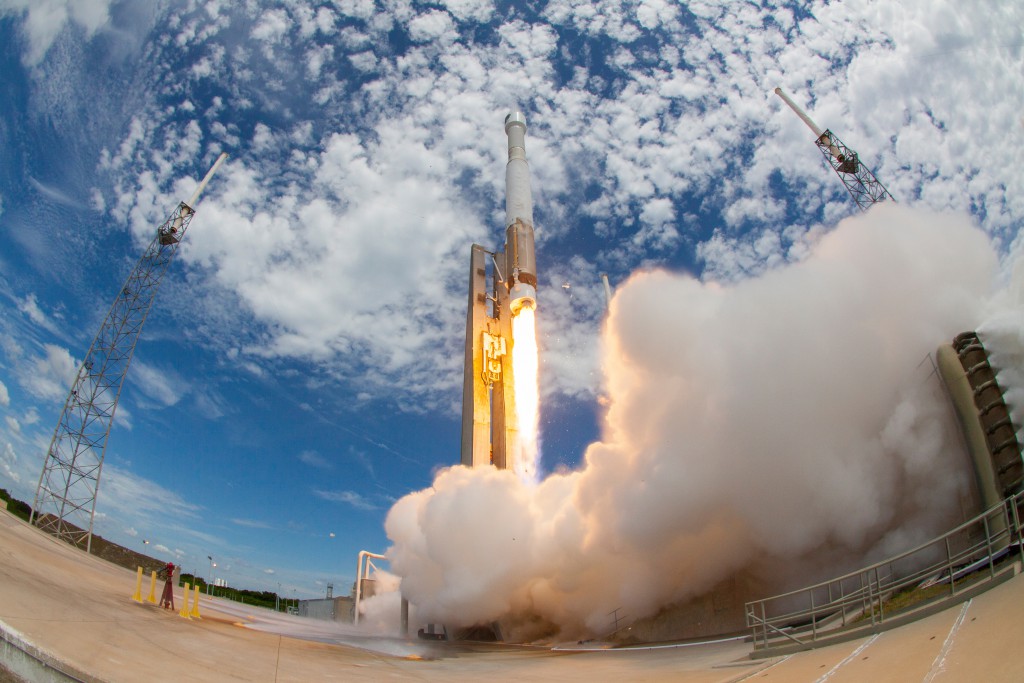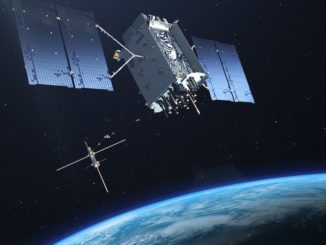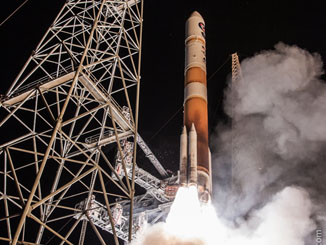Follow the Atlas 5 rocket’s ascent into orbit from Cape Canaveral’s Complex 41 launch pad with the U.S. Air Force’s GPS 2F-11 navigation satellite. Launch is scheduled for Friday at 12:17 p.m. EDT (1617 GMT).
T+0:00:01.1: Liftoff

The United Launch Alliance Atlas 5 vehicle, designated AV-060, will lift off and begin a vertical rise away from Complex 41 at Cape Canaveral Air Force Station, Florida.
T+0:01:18.5: Mach 1 and Max Q
![EyeTVSnapshot[1212]](http://spaceflightnow.com/wp-content/uploads/2015/10/EyeTVSnapshot1212-1024x576.jpg)
The Atlas rocket achieves Mach 1 some 78 seconds into the flight, then passes through the region of maximum dynamic pressure at 90 seconds.
T+0:04:04: Main Engine Cutoff
![EyeTVSnapshot[1214]](http://spaceflightnow.com/wp-content/uploads/2015/10/EyeTVSnapshot1214-1024x576.jpg)
The RD-180 main engine completes its firing after consuming the load of RP-1 kerosene fuel and liquid oxygen supply in the Atlas first stage.
T+0:04:10: Stage Separation
![EyeTVSnapshot[1215]](http://spaceflightnow.com/wp-content/uploads/2015/10/EyeTVSnapshot1215-1024x576.jpg)
The Common Core Booster first stage of the Atlas 5 rocket separates from the Centaur upper stage. Over the next few seconds, the Centaur engine liquid hydrogen and liquid oxygen systems are readied for ignition.
T+0:04:20: Centaur Ignition No. 1
![EyeTVSnapshot[1216]](http://spaceflightnow.com/wp-content/uploads/2015/10/EyeTVSnapshot1216-1024x576.jpg)
The Centaur RL10 engine ignites for the longer of the two upper stage firings. This burn will inject the Centaur stage and GPS 2F-11 spacecraft into a transfer orbit.
T+0:04:28: Nose Cone Jettison
![EyeTVSnapshot[1217]](http://spaceflightnow.com/wp-content/uploads/2015/10/EyeTVSnapshot1217-1024x576.jpg)
The two-piece, 14-foot-diameter payload fairing that protected the GPS 2F-11 craft during the atmospheric ascent is separated to reveal the satellite to space.
T+0:17:03: Centaur Engine Cutoff No. 1
![EyeTVSnapshot[1218]](http://spaceflightnow.com/wp-content/uploads/2015/10/EyeTVSnapshot1218-1024x576.jpg)
The Centaur engine shuts down after arriving in a planned elliptical transfer orbit of 11,000 by 90 nautical miles. The vehicle enters a three-hour coast period before arriving at the required location in space for the second burn.
T+3:17:01: Centaur Ignition No. 2
![EyeTVSnapshot[1219]](http://spaceflightnow.com/wp-content/uploads/2015/10/EyeTVSnapshot1219-1024x576.jpg)
The Centaur re-ignites to circularize the orbit and enter the Global Positioning System satellite constellation in delivery of GPS 2F-11.
T+3:18:28: Centaur Engine Cutoff No. 2
![EyeTVSnapshot[1220]](http://spaceflightnow.com/wp-content/uploads/2015/10/EyeTVSnapshot1220-1024x576.jpg)
At the conclusion of its second firing, the Centaur will have delivered the GPS spacecraft into the targeted circular orbit of 11,047 nautical miles, inclined 55 degrees to the equator.
T+3:23:14: Spacecraft Separation
![EyeTVSnapshot[1221]](http://spaceflightnow.com/wp-content/uploads/2015/10/EyeTVSnapshot1221-1024x576.jpg)
The Global Positioning System 2F-11 navigation satellite is released into orbit from the Centaur upper stage to complete the AV-060 launch.
See earlier GPS 2F-11 coverage.
Our Atlas archive.



